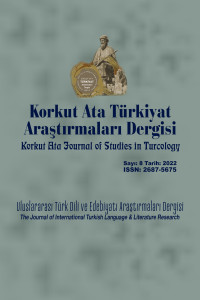Ahmet Paşa ve Hâfız’da “Ay” Unsurunun Kullanımı
Klasik Türk şiirinde tahayyül ve tasavvurlarda geniş yer tutan betimlemelerden biri de kozmik unsurların kullanımı olmuştur. Bu kullanımları sevgilinin şahsında dillendiren şairlerden biri de Ahmet Paşa olmuştur. Ahmet Paşa’nın “ay” unsuru bağlamında ele aldığı kozmik betimlemeler; Fars şiirinin güçlü şairlerinden Hâfız’dan aldığı etkilerle, hatta bu etkileri yer yer muhteva ve mazmunların kullanım biçimi bakımından aşan niteliklere sahiptir. Hâfız, bir aşk adamı ve rint olarak sevgili bağlamında “ay”ı; Yusuf güzeli imajlar, sevgilinin hilal kaşının cilvesine tutkunluk/âşık olma nedeni, ayın kaybolması/sevgilinin gitmesiyle başlayan ayrılık, sevgilinin ay yüzü ile sabahları aydınlatması, ay ağılı misali parıltı ve güzelliğe sahip olması, gökteki ayı güzelliğiyle geride bırakması, bir ay gibi gönle doğması, meclise bir ay gibi doğması/gelmesi ile bin takva ve hırkayı ay yüzlü sevgili uğruna yakma olgusu gibi geniş ve ay misali parlak teşbihlerle anlatmıştır. Ahmet Paşa ise; çıkması ile Ramazan ayını müjdelemesi, ayağına feleğin inci, mücevher saçması, eğri hilal kaşın Akrep burcunda ışıması, Erjengin tuvalinin parıltısını geride bırakması, Yusuf yüzlü/ay, aşığın beden burcuna kılıç misali saplanan güzel imajı, yeni ayı ve feleği parlaklık ve nicelik bakımından geride bırakması gibi sevgilinin benzetilenleri bağlamında ay ve diğer kozmik unsurlara üstünlüğü ve eşsiz güzelliği bağlamında resmetmiştir. Ahmet Paşa, Hâfız’ın anlatım gücüne ulaşamasa da bu teşbihlerden farklı olarak “ay” unsurunu, sosyal hayata ait olgularla da bütünleştirmiş, vuslat-birliktelik-hâneye gelen sevgilinin ay misali ışıldıyan tavırları gibi şuh sevgilinin şahsında oldukça uçarı anlatımlarla da anlatmıştır. Ayrıca Ahmet Paşa, “ay”ı mahbup olarak da görmüş, ona yönelttiği farklı arzular bağlamında da dillendirmiştir. Bu çalışmada, ay misali bir ışıltı ve güzellik bağlamında etkili ve geniş bir anlatımı bütünleyen bu unsurlar, benzer ve farklı yönleri ile mukayeseli olarak dillendirilmiştir. Yapılan mukayeseler, kozmik genişliği misali klasik şiirin zengin teşbihleri ve anlatımları ile sunulmuştur.
Anahtar Kelimeler:
Ay, Hâfız, Ahmet Paşa, çeşitli kozmik imajlar.
The Use of the “Month” Element in Ahmed Pasha and Hâfız
One of the descriptions which occupies a wide place in imagination and descriptions of classical Turkish poetry is the use of cosmic elements. One of the poets who expressed these usages in the person of his beloved one was Ahmed Pasha. The cosmic descriptions that Ahmed Pasha dealt with in the context of the “moon” element, with the influences he received from Hafez, one of the powerful poets of Persian poetry, he even surpasses what influences him in terms of content and usage of metaphors. Hafez has described the moon in the context of a man of love as a rint, with wide and bright similes like the moon such as beautiful images of Joseph, the reason why the lover fell in love with the quirk of the crescent eyebrow, the disappearance of the moon/separation that started with the departure of the lover, the lover’s light in the morning with the moon’s face, the moon-like shine and beauty, leaving the moon in the sky behind with its beauty, being born into the heart like a moon, like the phenomenon rising to the divan like a moon, burning a thousand taqwas and cardigans for the sake of a moon-faced lover. Ahmed Pasha, on the other hand, portrayed the lover in the context of the likeness of the moon and other cosmic elements in the context of its superiority and unique beauty as follows: heralds the month of Ramadan with the rising of the moon, the pearls and jewels scattering on her feet, the crooked crescent brow shines in the sign of Scorpio, the brilliance of the Erjengin canvas leaves behind, the face of Joseph/moon, the beautiful image of the lover stabbed into the body sign like a sword, the new moon and the sky are behind in terms of brightness and quantity. Although Ahmed Pasha could not reach the expressive power of Hafez, unlike these similes, he integrated the “moon” element with the facts of social life, he also expressed it in quite different expressions in the person of the lover, such as the moon-like attitudes of the lover who came to the house. In addition, Ahmed Pasha adopted the “moon” as a beloved one and expressed it in the context of the different desires he directed towards it. In this study, these elements, which complement an effective and broad expression in the context of a moon-like glow and beauty, are expressed comparatively with their similar and different aspects. The comparisons are presented with rich similes and expressions of classical poetry as the epitome of cosmic breadth.
Keywords:
Moon, Hafez, Ahmed Pasha, various cosmic images.,
___
- Akün, Ö. F. (1994). Divan Edebiyatı. TDV İslam Ansiklopedisi (C. 9, s. 389-427). İstanbul: TDV Yayınları.
- Ay, Ü. (2009). Divan Şiirinde Güneşin Sevgili Tipine Yansıması Hakkında Bir Değerlendirme. Divan Edebiyatı Araştırmaları Dergisi, 2(2), 117-162.
- Hâfız-ı Şirâzî. (2011). Hâfız Divânı, (Çev: Mehmet Kanar), İstanbul: Ayrıntı Yayınları.
- Hâfız-ı Şirâzî. (1971). Divân-ı Hafız (Tashîh: Nizame’d-dîn Nuri). Tahran: İntişârât-ı Mürekkeb-i Sepîd. 1387 h.ş.
- Kınaytürk, M. (2021). Hâfız Divânında Sevgili ve Sevgilinin Yüz ve Yanak Güzelliği Üzerine Yapılan Benzetmeler. Hikmet-Akademik Edebiyat Dergisi, 7(14), 282-296.
- Sevimli, E. (2022). Rafine Bir Hak Âşıklığının Edebî Seyri Klasik Şiirde Melâmet Düşüncesi ve Melamilik. Ankara: Gece Kitaplığı Yayınları.
- Tarlan, A. N. (1992). Ahmet Paşa Divanı. Ankara: Akçağ Yay.
- Başlangıç: 2019
- Yayıncı: Yunus KAPLAN
Sayıdaki Diğer Makaleler
Öğretmenlerin İyi Oluşunun Yordayıcıları: TALIS 2018 Türkiye Örneklemi
Folklorda Feminist Kodlama Stratejileri: Ankara Kalecik Örneği
Türkçede Sezdirim: Duvar Yazıları Örneği
“defa, kere ve kez” Sözcüklerinin Eşdizimliliği Üzerine Derlem Tabanlı Bir İnceleme
Sağlık Çalışanlarında Duygusal Tükenmişlik ve Yabancılaşma Arasındaki İlişkinin İncelenmesi
Sâmiha Ayverdi’nin Eserlerinde Musiki
Sefaradi Halk Edebiyatında Modern Coha Fıkraları: Selim Salti Örneği
Kutadgu Bilig’de Alıntı Sözcükler ve Bu Sözcüklerin Türkçeleştirilme Yolları
